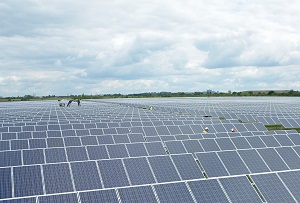As UK’s solar window closes, Conergy constructs largest project in nation
 Necessity is the mother of invention, the saying goes, but it appears Great Britain’s feed-in tariff is the mother of really fast engineering and production. That would explain how German-based solar installer Conergy managed to construct the UK’s largest solar field in only six weeks, much faster than standard installations.
Necessity is the mother of invention, the saying goes, but it appears Great Britain’s feed-in tariff is the mother of really fast engineering and production. That would explain how German-based solar installer Conergy managed to construct the UK’s largest solar field in only six weeks, much faster than standard installations.
Conergy raced to build the 5 MW field, located in Hawton, Nottinghamshire, because the British government is soon ending its feed-in tariff program, which helps subsidize the cost of building solar installations. To benefit from the tariff, Conergy and other installers are moving quickly to build before the July 31 deadline.
Conergy announced that the field consists of 21,600 photovoltaic panels covering 14.6 hectares of land. Conergy’s UK marketing manager, Johanna Kattinger, said the field will offset 2,535 tons of carbon dioxide production annually.
The Hawton field was constructed by Conergy but was developed and is owned by Lightsource Renewable Energy, with funding from Octopus Investments. Employment numbers offered by the project were not immediately available.
Of the quick construction, Kattinger said in an email, “Time was very critical, and everybody had to work to a tight schedule. All parties were working very hard to get this project finished in time.”
Why the rush?
According to an article from Renewables International, any given solar project would have lost somewhere in the vicinity of 72 percent of its profits from electricity generated if it hadn’t been finished in time.
According to Kattinger, the end of the feed-in tariffs means Conergy will be focusing on small-scale solar projects in Britain for the time being.
“Conergy’s main focus in the UK is on domestic projects,” Kattinger said. “Eighty percent of our current business is focused on private homes with installations below 4 kW and thus not affected by the recent revised feed-in tariffs.”
Changes in Britain’s tariff laws will raise costs for solar installations greater than 50 kW, a rule change by the Office of Energy and Climate Change.
The office is attempting to encourage small-scale projects over large-scale ones, according to a statement by Secretary Chris Huhne. Installations must be connected to Britain’s power grid before Aug. 1 to qualify for current feed-in tariff rates.



